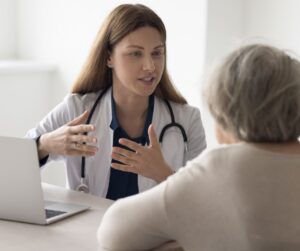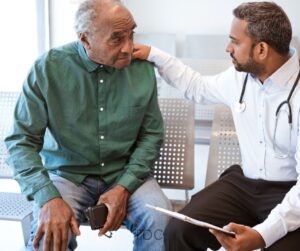Cancer is a formidable adversary, and for the estimated 86,000 individuals between the ages of 15 and 39 at initial diagnosis in 2023 in the United States, it presents a unique set of challenges.1 This group, known as the adolescent and young adult (AYA) oncology population, accounted for approximately 4% of all new cancer cases in 2023.1,2 And an estimated 9,000 AYAs would have lost their lives to cancer in 2023 in the United States.1
On average, the number of new cancer cases among AYAs increased by 0.3% each year from 2010 to 2019. Meanwhile, death rates decreased by 0.9% annually from 2011 to 2020.1 Female breast cancer is the most frequently diagnosed among AYA cancers, with an age-adjusted rate of 23.0 new cases per 100,000 females.1 Testicular cancer follows as the second most common cancer in this age group, affecting 11.6 out of every 100,000 males.1 Thyroid cancer also has a significant impact on AYAs, with an age-adjusted rate of 11.3 new cases per 100,000 individuals in this population.1
Other cancers in AYAs include3
- Melanoma
- Brain and other central nervous system tumors
- Cervical cancer
- Colorectal cancer
- Leukemia
- Lymphoma
- Sarcomas (both bone and soft tissue)
Recent advancements in cancer treatment have led to lower mortality rates among the AYA population.2 Notably, the 5-year survival rate across all AYA cancer types is nearly 86%.1 Compared to children (85.1%) and adults aged 40 to 64 (74.1%), AYAs show higher survival rates.1 This can be attributed to AYA patients having a higher rate of less aggressive cancers, such as thyroid cancer, with a high 5-year relative survival rate of 99.8% in this population.1,4 However, this improvement is less pronounced compared to the progress seen in children and older adults.4
Cancer in AYAs presents distinct challenges compared to other age groups due to variations in cancer types, risk factors, tumor biology, and outcomes.5 AYAs are also more likely to experience delays in diagnosis for certain cancers.5
How AYA cancer care evolved over the years
Following is a brief summary of the history and evolution of AYA cancer care.
In the 1990s, healthcare professionals started acknowledging that AYAs diagnosed with cancer weren’t experiencing the improved outcomes seen in both children and older adults. This disparity in outcomes led to the coining of the term “AYA gap.”4,7
One contributing factor to this disparity was the low participation of AYAs in cancer clinical trials.8 Despite the unique challenges faced by AYAs, this population is underrepresented in research, leading to a lack of awareness about their specific needs and the most effective ways to provide age-appropriate, comprehensive care.8
In 2006, the National Cancer Institute (NCI) and the Lance Armstrong Foundation (now known as the LIVESTRONG Foundation) organized the AYA Oncology Progress Review Group (AYAO PRG) to identify gaps and challenges in AYA oncology care and research.6,7
The group highlighted several key recommendations. These included the need to recognize and address health disparities faced by AYA patients with cancer, provide education and raise awareness about AYA cancer, and enhance advocacy and support for this unique patient population.9 Hospitals and cancer centers began to establish AYA-specific programs.
In 2012, the National Comprehensive Cancer Network (NCCN) released the first Clinical Practice Guidelines in Oncology for AYAs.2 The NCCN Guidelines emphasize the importance of providing specialized care for AYA patients with cancer.
They strongly advise that AYA patients receive care from a multidisciplinary team of healthcare professionals. This team should possess expertise not only in treating AYA cancers but also in addressing the unique developmental challenges faced by this age group. These challenges include a wide range of issues, such as fertility, sexual function, education, career development, employment, family planning, pregnancy, sexually transmitted diseases, and substance use disorders.2
The rationale behind this recommendation is multifaceted. First, a multidisciplinary approach to treatment is crucial for AYA patients with cancer. Secondly, referring AYA patients to cancer centers with broad access to clinical trials can improve their enrollment in such trials. Finally, these centers are generally better equipped to address the distinctive physical and psychosocial needs of AYA patients and can offer access to supportive care services.2
The NCCN Guidelines offer comprehensive support that goes beyond treatment recommendations. They also provide guidance on fertility preservation, psychosocial and behavioral assessment and management, as well as socioeconomic issues that may impact AYA patients.2 Furthermore, the NCCN’s Adolescent and Young Adult Cancer patient guide is a valuable resource for patients and caregivers.10
The unique needs of AYA patients
AYA oncology patients have distinct needs that set them apart from both pediatric and older adult patients. These needs include:
Psychosocial support: AYAs face a myriad of challenges, including identity formation, relationship dynamics, and emotional well-being, all of which are further complicated by their cancer diagnosis.11
Coping with cancer during this critical period of development and growth can significantly impact their ability to navigate milestones such as education, career advancement, and family planning. It’s a time when they are establishing their identity and independence, yet they must also grapple with existential questions and navigate the complexities of the healthcare system. These additional stressors exacerbate the already significant emotional burden of adolescence and young adulthood.11
The struggle to keep pace with their peers can lead to feelings of social isolation. This loneliness can make the cancer experience even more challenging, as AYAs may feel like they are going through their journey alone.11
Fertility, sexual activity, and intimacy discussion: Cancer treatment can affect fertility, which is a significant concern for many AYAs who may not have started or completed their families. Access to fertility preservation options and counseling is key, yet it’s often overlooked in this population.11
The physical changes caused by treatment, such as hair loss, surgical scars, and body composition alterations, can lead to self-consciousness and difficulties with intimacy. The emotional toll of cancer, including anxiety and depression, can further compound these challenges, affecting sexual desire and function. AYAs may feel hesitant to discuss these sensitive topics, even with close partners, leading to feelings of isolation and strain on relationships.11
Financial assistance: Young adult cancer patients may face significant financial challenges along with their diagnosis. This patient population is often uninsured or underinsured. Limited insurance coverage, high out-of-pocket costs, and loss of income due to treatment can create a substantial financial burden. Many AYAs report that the stress of managing the financial aspects of their care can be even more overwhelming than the emotional impact of the diagnosis itself.11
With limited savings, early-stage careers, and a lack of financial experience, young adults are particularly vulnerable to the economic strain of cancer care. Non-healthcare expenses, such as student loans, can further compound these challenges. The financial toxicity of cancer can have long-lasting effects on AYAs’ lives, including the risk of debt, inability to save for the future, and overall financial stress.11,13
Survivorship care: The transition to post-treatment care can be difficult as AYAs process their experience and redefine their identity.11 Many AYA cancer survivors have unmet needs for information and support services, particularly regarding their cancer recurrence risk and treatment options. The AYA HOPE study found that more than half of survivors lacked the necessary information in these areas.12
The risk of long-term effects of cancer depends on age at initial diagnosis, treatment received, family history, lifestyle behaviors, and comorbidities. Additionally, planning for the future can feel overwhelming.11
End-of-life care: When curative treatment is no longer an option, AYAs have distinct needs related to end-of-life care. This includes age-appropriate communication, support for loved ones, and opportunities for legacy-building activities.14
AYAs facing death may find themselves particularly vulnerable, as it goes against the natural order of life, where each generation typically outlives the one before. They encounter profound losses, such as missed opportunities to build relationships, start families and careers, and the prospect of living into old age.14
Challenges when caring for AYAs in oncology
Providing care to AYA patients with cancer presents a multitude of challenges due to their unique developmental stage, psychosocial needs, and socioeconomic circumstances.
Non-adherence is a significant challenge in AYA patients with cancer, characterized by missed appointments, refusal of tests or treatments, and failure to follow medical recommendations. This issue is more common among AYAs compared to other age groups and is associated with poorer clinical outcomes.11 The increased likelihood of non-adherence in AYAs is multifactorial, stemming from their developmental stage and life circumstances. Factors such as asserting autonomy, lack of social support, financial barriers, emotional distress, and insufficient understanding of the importance of adherence can all contribute to non-adherence.4,11
AYAs may face delays in diagnosis. This is largely due to both patients and healthcare providers often not considering cancer as a likely possibility in this young population.5 In addition to the relative rarity of cancer in this age group, which can lead to a lower index of suspicion among medical professionals, AYAs also face higher uninsured rates and lack of accessible screening tests. Consequently, AYAs may experience delays in diagnosis compared to older cancer patients.5
As previously mentioned, the high costs associated with cancer treatment in this population that is often uninsured or underinsured can create substantial financial barriers for AYAs. Inadequate insurance coverage can lead to limited access to treatments, delays in care, and increased financial stress for patients and their families. Lack of insurance or insufficient coverage can make it difficult for AYAs to access age-appropriate psychosocial support services, fertility preservation options, or long-term survivorship care. These financial challenges can compound the already complex emotional burdens of a cancer diagnosis, potentially impacting treatment adherence and outcomes.13
The underrepresentation of AYAs in clinical trials has far-reaching consequences for their care and outcomes. Without adequate representation in research, the unique biological, psychological, and social factors that influence treatment response and long-term outcomes in AYAs remain poorly understood. This lack of evidence-based guidance can leave healthcare providers ill-equipped to make informed decisions and provide the most effective care for their AYA patients.15
Why APP engagement matters for AYA patients
Advanced practice providers (APPs) play a pivotal role in providing comprehensive care to AYA patients. When APPs understand the unique psychosocial needs of this population, they can better support their patients and help them navigate the cancer journey more effectively. Engaging in psychosocial support allows APPs to focus on the whole person, not just the medical aspects of their care.
APPs should be proactive in addressing fertility, sexual activity, and intimacy concerns with AYA patients. Having open conversations empowers these patients to make informed choices about their care, preserve fertility options, and maintain healthy relationships during and after treatment.
While financial expertise may be outside their scope, APPs who are aware of the financial challenges faced by AYA patients can better advocate for their needs and connect them with appropriate resources.
When it comes to survivorship care, engaged APPs can help patients manage the long-term physical and psychosocial effects of cancer and its treatment, as well as address concerns such as fear of recurrence.
For AYA patients facing end-of-life realities, APPs can provide compassionate, age-attuned care grounded in dignity and support. They can initiate difficult yet necessary end-of-life conversations and guide AYAs and their caregivers through this challenging time with empathy. APPs achieve this by not only having open dialogues about end-of-life matters but also connecting patients and families to supportive resources.
How APPs Can Support AYA Patients With Cancer
- Champion and participate in the development of an AYA oncology program at their institution.
- Intervene early with mental health resources and coping strategies.
- Educate themselves on the unique needs of this population and the available resources to support them.
- Assess barriers to treatment adherence and work with AYAs to develop personalized strategies to overcome these challenges.
- Identify patients’ needs and ensure that appropriate and timely referrals are made.
- Be creative and find unique ways to engage and connect with each AYA patient, understanding their risk for feelings of isolation.
- Discuss fertility preservation options and refer patients to appropriate specialists timely.
- Counsel young adult patients regarding safe sexual activity and intimacy during treatment, including the use of condoms and additional contraceptive methods.
- Connect patients with appropriate financial assistance resources, such as social workers, financial navigators, or community organizations.
- Advocate for the inclusion of AYAs in clinical trials and provide information and support to help them make informed decisions about participation.
- Start discussing survivorship early on the cancer journey.
- Refer patients to palliative care teams who can address their unique needs and connect them with appropriate resources.
- Communicate openly and thoughtfully with AYA patients about end-of-life care.11
Conclusion
It’s clear that the AYA population, though small in number, requires a specialized approach to care. The medical and psychosocial needs of AYAs are distinct from those of other age groups. APPs are well-positioned to make a significant impact on the cancer experiences of these young individuals by proactively assessing their needs and engaging in meaningful conversations throughout their cancer journey. The role of APPs extends beyond medical treatment. They serve as a vital link between AYA patients and the resources and services necessary to enhance their overall care.
Maggie Aime, MSN, RN, is a health, wellness, and medical personal finance writer with over 25 years of experience in healthcare, including working in oncology in both non-clinical and nursing roles. With a passion for education, she draws on her diverse background across nursing specialties, oncology case management, revenue management, and utilization review to create empowering content.
Se also: Provider Perspective: Building an AYA Program at Mass General Cancer Center
For more information
ClinicalTrials.gov: Offers a database of privately and publicly funded clinical studies on a wide range of diseases and conditions, including cancer trials.
Stupid Cancer: Offers support, resources, and community for AYA cancer patients and survivors.
Teen Cancer America: Focuses on improving the lives of AYA cancer patients by providing specialized facilities, support, and research.
The OncoFertility Consortium: Focuses on preserving fertility and reproductive health in young cancer patients through research, education, and clinical care initiatives.
The SAMFund: Provides financial assistance and support for AYA cancer survivors.
The Ulman Foundation: Provides support, education, and resources for AYA cancer patients and survivors, including scholarships and social activities.
Triage Cancer: Offers information on health insurance navigation, employment rights, and insurance appeals to alleviate financial toxicity and burden.
Young Survival Coalition: Provides support, resources, and community for young adults diagnosed with breast cancer.
References
- Cancer among adolescents and young adults (AYAs). (n.d.). National Cancer Institute Surveillance, Epidemiology, and End Results Program https://seer.cancer.gov/statfacts/html/aya.html
- Bhatia, S., Pappo, A. S., Acquazzino, M., Allen-Rhoades, W. A., Barnett, M., Borinstein, S. C., Casey, R., Choo, S., Chugh, R., Dinner, S., Ermoian, R., Fair, D., Federman, N., Folbrecht, J., Gandhi, S., Germann, J., Goldsby, R., Hayashi, R., Huang, A. Y., Huang, M. S., … Hang, L. (2023). Adolescent and young adult (AYA) oncology, version 2.2024, NCCN clinical practice guidelines in oncology. Journal of the National Comprehensive Cancer Network: JNCCN, 21(8), 851–880. https://doi.org/10.6004/jnccn.2023.0040
- Adolescents and young adults with cancer. (n.d.). National Cancer Institute. https://www.cancer.gov/types/aya
- Coccia P. F. (2019). Overview of adolescent and young adult oncology. Journal of oncology practice, 15(5), 235–237. https://doi.org/10.1200/JOP.19.00075
- Miller, K. D., Fidler-Benaoudia, M., Keegan, T. H., Hipp, H. S., Jemal, A., & Siegel, R. L. (2020). Cancer statistics for adolescents and young adults, 2020. CA: a cancer Journal for Clinicians, 70(6), 443–459. https://doi.org/10.3322/caac.21637
- Close, A. G., Dreyzin, A., Miller, K. D., Seynnaeve, B. K. N., & Rapkin, L. B. (2019). Adolescent and young adult oncology—past, present, and future. CA: a cancer journal for clinicians, 69(6), 485–496. https://doi.org/10.3322/caac.21585
- Bleyer A. (2007). Young adult oncology: The patients and their survival challenges. CA: a cancer journal for clinicians, 57(4), 242–255. https://doi.org/10.3322/canjclin.57.4.242
- Freyer, D. R., & Seibel, N. L. (2015). The clinical trials gap for adolescents and young adults with cancer: Recent progress and conceptual framework for continued research. Current pediatrics reports, 3(2), 137–145. https://doi.org/10.1007/s40124-015-0075-y
- Closing the gap: Research and care imperatives for adolescents and young adults with cancer. Report of the adolescent and young adult oncology progress review group. (2006). National Cancer Advisory Board Meeting. https://deainfo.nci.nih.gov/advisory/ncab/archive/139_0906/presentations/AYAO.pdf
- Adolescent and young adult cancer. (2023). NCCN Guidelines for Patients. https://www.nccn.org/patients/guidelines/content/PDF/aya-patient.pdf
- Jin, Z., Griffith, M. A., & Rosenthal, A. C. (2021). Identifying and meeting the needs of adolescents and young adults with cancer. Current oncology reports, 23(2). https://doi.org/10.1007/s11912-020-01011-9
- Keegan, T. H., Lichtensztajn, D. Y., Kato, I., Kent, E. E., Wu, X.-C., West, M. M., Hamilton, A. S., Zebrack, B., Bellizzi, K. M., & Smith, A. W. (2012). Unmet adolescent and young adult cancer survivors information and service needs: A population-based cancer registry study. Journal of Cancer Survivorship, 6(3), 239–250. https://doi.org/10.1007/s11764-012-0219-9
- Skinner, A., Buhlmann, M., Fridley, B. L., Reed, D. R., Vicedo, D., & Mason, N. T. (2023). Pilot study in investigating material financial toxicity markers by age in cancer patients. Journal of adolescent and young adult oncology, 12(1), 34–42. https://doi.org/10.1089/jayao.2022.0011
- Mack, J. W., Fisher, L., Kushi, L., Chao, C. R., Vega, B., Rodrigues, G., Josephs, I., Brock, K. E., Buchanan, S., Casperson, M., Cooper, R. M., Fasciano, K. M., Kolevska, T., Lakin, J. R., Lefebvre, A., Schwartz, C. M., Shalman, D. M., Wall, C. B., Wiener, L., & Altschuler, A. (2021). Patient, family, and clinician perspectives on end-of-life care quality domains and candidate indicators for adolescents and young adults with cancer. JAMA Network Open, 4(8). https://doi.org/10.1001/jamanetworkopen.2021.21888
- Bleyer, A., Tai, E., & Siegel, S. (2018). Role of clinical trials in survival progress of American adolescents and young adults with cancer—and lack thereof. Pediatric blood & cancer, 65(8). https://doi.org/10.1002/pbc.27074







